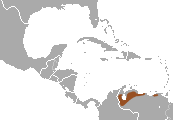Crown shrew pouch rat
| Crown shrew pouch rat | ||||||||||||
|---|---|---|---|---|---|---|---|---|---|---|---|---|
| Systematics | ||||||||||||
|
||||||||||||
| Scientific name | ||||||||||||
| Monodelphis palliolata | ||||||||||||
| ( Osgood , 1914) |
The crowned shrew rat ( Monodelphis palliolata , synonym : Peramys palliolatus ) occurs in the north of Venezuela and in the northeast of Colombia ( Departamento de Norte de Santander ).
description
Males of the crowned shrew rat reach a head body length of 12.3 to 18.3 cm, have a 7 to 10.5 cm long tail and weigh 49 to 106 g. Females stay significantly smaller and have a head body length of 10.2 to 14.1 cm, a tail length of 5.5 to 8.8 cm and a weight of 32 to 63 g. The fur on the back and the top of the head is light gray. The sides of the body are orange, the belly is gray-orange and does not contrast clearly with the sides of the body. The hair on the back is approx. 8 mm long, on the belly it is only 4 mm long. The paws are gray, the ears small and solid gray. The tail is hairy and gray in color only on the first quarter close to the body. There are no dark circles under the eyes. Like probably all shrew pouch rats, the females do not have a pouch. The number of teats is unknown. The karyotype of Arlindo's shrew pouch rat is 2n = 18, FN = 20 or 30.
Way of life
The crowned shrew pouch rat occurs in dry forests and in premontaneous, more or less humid forests from sea level to altitudes of 2200 meters. It is adaptable and has also been caught on coffee plantations and other agricultural areas. The diet of the crepuscular and terrestrial (ground-dwelling) species has not yet been researched. The animals reproduce during the rainy season from May to August and in November. On average, 7 to 8 pups are born per litter, which reach sexual maturity at 6 months of age.
status
The crowned shrew pouch rat is listed as safe by the IUCN because of its abundance, its relatively large distribution area and its occurrence in several protected areas. In northern Venezuela, 25 to 100 specimens of the crowned shrew pouch rat have been found per square kilometer. However, as deforestation continues to increase in its range, this assessment could change in the near future.
supporting documents
- ↑ a b c d Diego Astúa: Family Didelphidae (Opossums). in Don E. Wilson , Russell A. Mittermeier : Handbook of the Mammals of the World - Volume 5. Monotremes and Marsupials. Lynx Editions, 2015, ISBN 978-84-96553-99-6 . Page 150 and 151
- ↑ Monodelphis palliolata in the endangered Red List species the IUCN 2016 Posted by: Perez-Hernandez, R., Ventura, J. & López Fuster, M., 2015. Accessed January 18, 2020th
